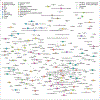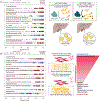Mapping the proteo-genomic convergence of human diseases
- PMID: 34648354
- PMCID: PMC9904207
- DOI: 10.1126/science.abj1541
Mapping the proteo-genomic convergence of human diseases
Abstract
Characterization of the genetic regulation of proteins is essential for understanding disease etiology and developing therapies. We identified 10,674 genetic associations for 3892 plasma proteins to create a cis-anchored gene-protein-disease map of 1859 connections that highlights strong cross-disease biological convergence. This proteo-genomic map provides a framework to connect etiologically related diseases, to provide biological context for new or emerging disorders, and to integrate different biological domains to establish mechanisms for known gene-disease links. Our results identify proteo-genomic connections within and between diseases and establish the value of cis-protein variants for annotation of likely causal disease genes at loci identified in genome-wide association studies, thereby addressing a major barrier to experimental validation and clinical translation of genetic discoveries.
Conflict of interest statement
COMPETING INTERESTS
RAS and AC are current employees and/or stockholders of GlaxoSmithKline. ERG receives an honorarium from the journal Circulation Research of the American Heart Association as a member of the Editorial Board. SOR has received remuneration for consultancy services provided to Pfizer Inc, Astra Zeneca, ERX Pharmaceuticals, GSK, Third Rock Ventures and LG Life Sciences. All other authors declare that they have no competing interests.
Figures






References
-
- Emilsson V, Ilkov M, Lamb JR, Finkel N, Gudmundsson EF, Pitts R, Hoover H, Gudmundsdottir V, Horman SR, Aspelund T, Shu L, Trifonov V, Sigurdsson S, Manolescu A, Zhu J, Olafsson Ö, Jakobsdottir J, Lesley SA, To J, Zhang J, Harris TB, Launer LJ, Zhang B, Eiriksdottir G, Yang X, Orth AP, Jennings LL, Gudnason V, Co-regulatory networks of human serum proteins link genetics to disease. Science 361, 769–773 (2018). - PMC - PubMed
-
- Suhre K, Arnold M, Bhagwat AM, Cotton RJ, Engelke R, Raffler J, Sarwath H, Thareja G, Wahl A, Delisle RK, Gold L, Pezer M, Lauc G, Selim MAED, Mook-Kanamori DO, Al-Dous EK, Mohamoud YA, Malek J, Strauch K, Grallert H, Peters A, Kastenmüller G, Gieger C, Graumann J, Connecting genetic risk to disease end points through the human blood plasma proteome. Nat. Commun 8 (2017), doi:10.1038/ncomms14357. - DOI - PMC - PubMed
-
- Folkersen L, Fauman E, Sabater-Lleal M, Strawbridge RJ, Frånberg M, Sennblad B, Baldassarre D, Veglia F, Humphries SE, Rauramaa R, de Faire U, Smit AJ, Giral P, Kurl S, Mannarino E, Enroth S, Johansson Å, Enroth SB, Gustafsson S, Lind L, Lindgren C, Morris AP, Giedraitis V, Silveira A, Franco-Cereceda A, Tremoli E, IMPROVE study group, Gyllensten U, Ingelsson E, Brunak S, Eriksson P, Ziemek D, Hamsten A, Mälarstig A, Mapping of 79 loci for 83 plasma protein biomarkers in cardiovascular disease. PLoS Genet 13, e1006706 (2017). - PMC - PubMed
-
- Sun BB, Maranville JC, Peters JE, Stacey D, Staley JR, Blackshaw J, Burgess S, Jiang T, Paige E, Surendran P, Oliver-Williams C, Kamat MA, Prins BP, Wilcox SK, Zimmerman ES, Chi A, Bansal N, Spain SL, Wood AM, Morrell NW, Bradley JR, Janjic N, Roberts DJ, Ouwehand WH, Todd JA, Soranzo N, Suhre K, Paul DS, Fox CS, Plenge RM, Danesh J, Runz H, Butterworth AS, Genomic atlas of the human plasma proteome. Nature 558, 73–79 (2018). - PMC - PubMed
-
- Yao C, Chen G, Song C, Keefe J, Mendelson M, Huan T, Sun BB, Laser A, Maranville JC, Wu H, Ho JE, Courchesne P, Lyass A, Larson MG, Gieger C, Graumann J, Johnson AD, Danesh J, Runz H, Hwang S-JJ, Liu C, Butterworth AS, Suhre K, Levy D, Genome‐wide mapping of plasma protein QTLs identifies putatively causal genes and pathways for cardiovascular disease. Nat. Commun 9, 3268 (2018). - PMC - PubMed
Publication types
MeSH terms
Substances
Grants and funding
LinkOut - more resources
Full Text Sources

